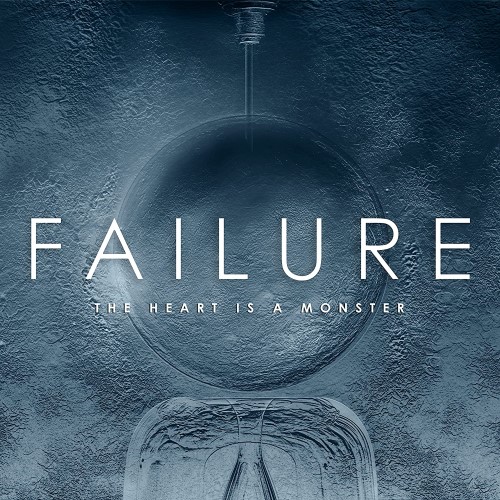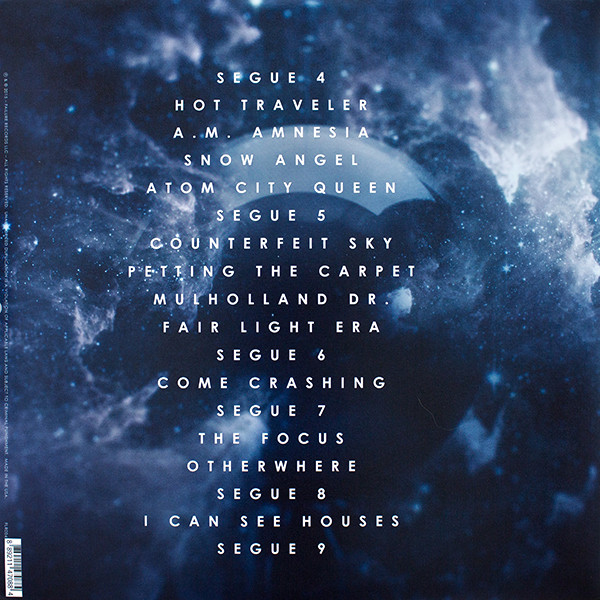Rediscovering: Failure’s The Heart is a Monster
- Posted by mariteaux on October 10th, 2020 filed in Rediscovering
- Comment now »
I am incredibly biased against comeback records. Even from my most cherished bands, far too often, the records utterly pale not just next to the expectations up to the ionosphere thanks to two decades of articles, retellings, and fan word of mouth, but pale next to as unbiased a look at their classic records as you can get. Sometimes, it’s hardly for lack of trying; it’s just a misguided sense of where the focus should’ve gone.
Yeah, I don’t want to have to write this one. Wishkah was ultimately a wash, but it still had me bouncing around to it for at least a few tracks. This one’s just kind of a downer, not totally meritless, certainly some cuts I do revisit, but I didn’t get the appeal then and I still don’t. At least this one has a happy ending.

Enter Failure’s 2015 comeback record The Heart is a Monster.
My previous experience, if any
Even though they’re the band I tend to be most associated as a fan with, I’ve never told the story of where exactly I found Failure. I was actually a big fan of Autolux (Greg Edwards’ later band) before Failure, and given my friend Logan’s recommendation and armed with a Spotify family account for the first time, I quickly grew into their seminal Fantastic Planet, one track at a time. Their others were even bigger favorites; Comfort stood as a bleak, hollow, cracking noise rock record with its share of…creature comforts (more of that Wal bass, please), and Magnified, I actually burnt out on for listening to it so much.
Yet, despite finding a CD of this one in my local record shop (on a trip with Logan, no less), despite liking this one’s follow-up, In the Future (which I reviewed a while back when I was still on Neocities)–this one got tried once and sat, like so many others in my collection.
The history lesson
Failure petered out in 1998 shortly after finding some measure of success with Fantastic Planet‘s fluke hit “Stuck on You” and opening on the main stage at Lollapalooza ’97. All went their separate ways, Ken Andrews towards his production work and Greg towards Autolux, but once a casual little reunion show sold out in seconds, it was clear Failure had to come back. Given both Ken and Greg had become talented studio gophers in their own right, it was no surprise when The Heart is a Monster was entirely self-recorded and independently released. The fans rejoiced, and the press were pleased. All’s well in the kingdom, yeah?
Well?
I’ve been hinting at it for a bit: this one’s disappointing. It’s mostly one aspect that sinks it, and that’s the pacing. For every single good track, The Heart is a Monster simply never finds itself in anything more than first gear, constantly interrupting its flow to vibe weakly. The biggest thing you can chalk this up to are the segues. If you’re not familiar with the concept, Comfort and Magnified both had these brief instrumental interludes between songs, and Fantastic Planet expanded them out into their own tracks. In a deliberate nod to that latter Failure album, this one starts right off with a “Segue 4”.
Hot take: segues always the most skippable and dull parts of Failure albums. I have no clue why they’ve become canon. They stem from Failure’s worst cinematic tendencies, the idea that they’re soundtracking a movie or something, but while a movie has dialogue, sights, and action to keep it moving, an album just has sounds. Certainly, they sound cool sometimes, but usually, they just needlessly drag the album’s pacing way down with tracks that are a minute long and don’t really do much of anything.
The Heart is a Monster has no less than six of these things. Of the last eight tracks, four are segues somehow. Have a peek at the back cover:

Of the segues, “Segue 4” isn’t even particularly well-blended into “Hot Traveler”, “Segue 9” just kinda starts up what “I Can See Houses” finished just fine, the two acoustic noodling segues are very weak “Segue 3” retreads, itself a retread of Magnified‘s “Segue X” (the interlude after “Magnified”), and the rest tend to just be ambient washes. Again, very occasionally, they’ll hit on a neat sound–“Segue 6” is eerie and unsettling, and “Segue 9” even has a bit of percussion to drive it–but you end up really, really wish they took these things and made actual songs out of them.
Call me a snob, but I want songs out of my albums. It just reeks of padding to sprinkle segues so liberally throughout the album, yet keep them at a minute’s length and prevent any sort of development or build to them. (Self-admitted padding! I remember an interview where Greg called them “a brief rest for your ears” or suchlike–can’t just turn the record off, I guess.) These are really not so mind-blowingly awesome that you’ll want to sit through them each time, I promise, especially not when they peter out and leave no impression so quickly.
I honestly don’t get it. Fantastic Planet was paced spectacularly, with the segues mostly segmenting out the tracklist into four chunks of tracks. Meanwhile, Autolux is fantastic at their mid-album slow songs–“Spots” from Transit Transit is exactly the kind of thing the segues should be. As these stand though, they just sound unfinished, and again, four in the last eight songs is inexcusable.
As for the actual songs, they range from lovely to fair. “Hot Traveler” is actually a pretty damn great opener and showcases how much different this Failure sounds to the classic Failure. Like I said, Ken and Greg both became total studio gophers in the time during Failure’s breakup, so it’s no surprise how clean and meticulous this one sounds. There’s hardly any grit to the drums, the bass tone is defined as a pleasant rumble, not muddy and ugly, and the bridge drops out to yet more ambient washes before the drums stomp back in. “A.M. Amnesia”, “Atom City Queen”, and “Counterfeit Sky” continue in its vein, and “Atom” especially has a pretty genuinely nasty guitar line in it and is probably my favorite song here.
It’s clear that Failure had intended The Heart is a Monster as a sort of fan pleaser, because aside from continuing the segues, two of its tracks are actually very very old Failure tracks originally featured on Golden. “Petting the Carpet” and “I Can See Houses” both got reworked and re-recorded, losing their respective era’s flavors in the process (no more Albini, no more Wal bass), but I think came out better for it. “I Can See Houses” is basically my proof that I don’t just hate subtle ambient tracks; over six-and-a-half minutes, the song builds from swells and an ominous little bassline into the simulated sounds of a plane falling through the air on a stormy night. It’s a genuinely effective closer, and should’ve been the closer.
There are yet more highlights later in the tracklist, but they’re almost not even worth mentioning. As an album, this falls flat. There’s no point on the album where Failure really gets on a roll for several songs in a row. The closest they have to that is the stretch between “Hot Traveler” and “Atom City Queen”, and even that’s got a “Snow Angel” in it to utterly underwhelm you. They try their hand at an epic piano ballad in “Mulholland Dr.” right after “Counterfeit” and “Carpet”, and once again, it just does nothing for how patience-testing this record can get. They seemed so dead set on proving their “sound design” meddle that the album never really gets up to speed. I feel like I’m constantly being interrupted in rocking the fuck out so the band can show me the neat layers they can put on things.
And let’s talk about that sound design for a moment. Fantastic Planet is generally considered a pretty raw album, and to that, I wager a Lou Barlow tape. “Solaris” and “Heliotropic” had texture to go along with their soundscapes. “Blank” had the hollow crowd chatter into its second verse; “Segue 2” mixed engine noises and synths in such a way you can almost visualize the protagonist strung out on the last of his recent score, watching stock car racing on TV. There was a sense that things around the record were still grounded on earth, even as its eyes shot skyward.
Nothing grounds The Heart is a Monster. There’s really no texture in the instruments. The sounds are glossy, not in the overproduced sense, but in the unimaginative, digital sense. No central premise gives the band any purchase over their arsenal of sounds. It’s like they’re trying their best to make whatever “space rock” is. The segues might be cinematic, but they don’t evoke anything other than the emptiness of space. Failure was once a rock band where the riffs came from the bass and the guitar did twinkly harmonics in the corner. I dunno what they were going for here.
I did promise a good ending, and thankfully, Failure delivered much more strongly on this album’s follow-up, as mentioned in the intro. The segues, though still present and still useless, are much less frequent and, like Fantastic Planet, used to split up sections of the album. In the Future delivers much more handily on this sort of very clean, meteoric album rock, much better ballads, seriously improved stompers, and a concept that actually feels like it goes somewhere. It’s just all-around the superior album.
As for The Heart is a Monster, it has its moments, but like they say in Atom City: “I had enough, I tried/I had enough, I shot it down”. One for the completionists only–and yes, that includes me.
Are you keeping it?
The softest, least enthusiastic “yes” I can muster.
